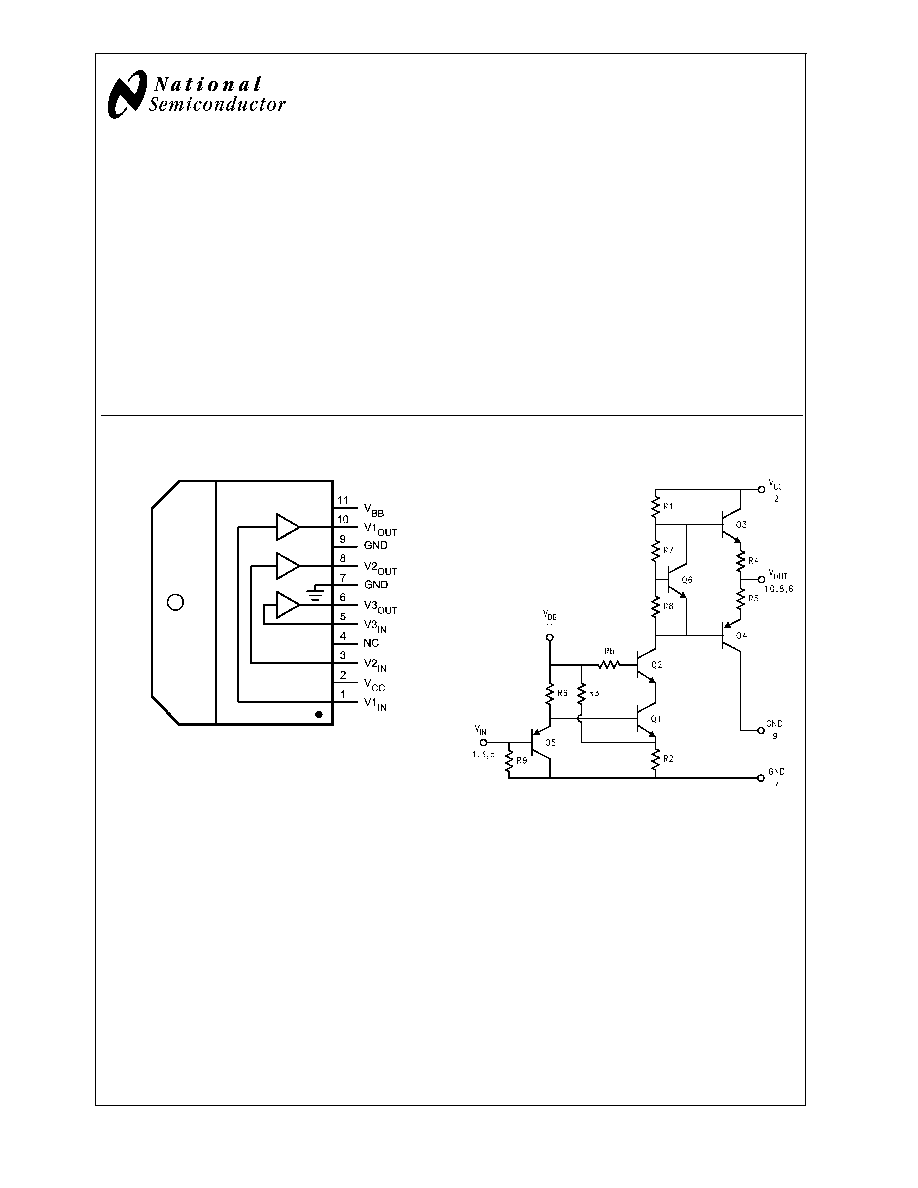
LM2422
220V Monolithic Triple Channel 30 MHz CRT DTV Driver
General Description
The LM2422 is a triple channel high voltage CRT driver
circuit designed for use in DTV applications. The IC contains
three high input impedance, wide band amplifiers which
directly drive the RGB cathodes of a CRT. Each channel has
its gain internally set to -52 and can drive CRT capacitive
loads as well as resistive loads present in other applications,
limited only by the package's power dissipation.
The IC is packaged in an industry standard 11-lead TO-220
molded plastic power package designed specifically to meet
high voltage spacing requirements. See Thermal Consider-
ations section.
Features
n
30 MHz bandwidth
n
Greater than 130V
P-P
output swing capability
n
0V to 5V input voltage range
n
Stable with 0 pF≠20 pF capacitive loads and inductive
peaking networks
n
Convenient TO-220 staggered thin lead package style
Applications
n
HDTV applications using the 1080i format as well as
other DTV and standard TV formats.
Connection Diagram
Schematic Diagram
20138201
FIGURE 1. Top View
Order Number LM2422
See NS Package Number TE11B
20138202
FIGURE 2. Simplified Schematic Diagram
(One Channel)
January 2005
LM2422
220V
Monolithic
T
riple
Channel
30
MHz
CRT
DTV
Driver
© 2005 National Semiconductor Corporation
DS201382
www.national.com

Absolute Maximum Ratings
(Notes 1,
3)
If Military/Aerospace specified devices are required,
please contact the National Semiconductor Sales Office/
Distributors for availability and specifications.
Supply Voltage (V
CC
)
+250V
Bias Voltage (V
BB
)
+16V
Input Voltage (V
IN
)
-0.5V to V
BB
+0.5V
Storage Temperature Range (T
STG
)
-65∞C to +150∞C
Lead Temperature
(Soldering,
<
10 sec.)
300∞C
ESD Tolerance,
Human Body Model
2 kV
Machine Model
200V
Junction Temperature
150∞C
JC
(typ)
1.8∞C/W
Operating Ratings
(Note 2)
V
CC
+100V to +230V
V
BB
+7V to +13V
V
IN
+0V to +5V
V
OUT
+40V to +215V
Case Temperature
(22W max power)
110∞C
Do not operate the part without a heat sink. Heat sink
must have a thermal resistance under 2.3∞C/W. (Note 7)
Electrical Characteristics
(See Figure 3 for Test Circuit). Unless otherwise noted: V
CC
= +220V, V
BB
= +12V, C
L
= 10 pF, T
C
= 60∞C. DC Tests: V
IN
=
+2.7V
DC
. AC Tests: Output = 110V
PP
(80V ≠ 190V) at 1 MHz.
Symbol
Parameter
Conditions
LM2422
Units
Min
Typ
Max
I
CC
Supply Current
No Input Signal, No Video Input, No
Output Load
36
45
54
mA
I
BB
Bias Current
18
27
36
mA
V
OUT, 1
DC Output Voltage
No AC Input Signal, V
IN
= 2.7V
DC
124
129
134
V
DC
V
OUT, 2
DC Output Voltage
No AC Input Signal, V
IN
= 1.2V
DC
200
205
210
V
DC
A
V
DC Voltage Gain
No AC Input Signal
-49
-52
-55
V/V
A
V
Gain Matching
(Note 4), No AC Input Signal
1.0
dB
LE
Linearity Error
(Notes 4, 5), No AC Input Signal
8
%
t
r
Rise Time, 60V to 190V
(Note 6), 10% to 90%
12
ns
+OS
Overshoot
12
%
t
f
Fall Time, 60V to 190V
(Note 6), 90% to 10%
12
ns
-OS
Overshoot
(Note 6)
4
%
Note 1: Absolute Maximum Ratings indicate limits beyond which damage to the device may occur.
Note 2: Operating ratings indicate conditions for which the device is functional, but do not guarantee specific performance limits. For guaranteed specifications and
test conditions, see the Electrical Characteristics. Datasheet min/max specification limits are guaranteed by design, test, or statistical analysis. The guaranteed
specifications apply only for the test conditions listed. Some performance characteristics may change when the device is not operated under the listed test
conditions.
Note 3: All voltages are measured with respect to GND, unless otherwise specified.
Note 4: Calculated value from Voltage Gain test on each channel.
Note 5: Linearity Error is the variation in DC gain from V
IN
= 1.15V to V
IN
= 4.35V.
Note 6: Input from signal generator: t
r
, t
f
<
1 ns.
Note 7: Running the 1 MHz to 30 MHz test pattern at 1080i this part will dissipate approximately 22 W. This is the commonly accepted test pattern that is
representative of the worst case high frequency content for normal television viewing. This is the pattern used to estimate the worst case power dissipation of the
LM2422 in its normal application. It is recommended to use a heat sink with a thermal resistance of 2.3∞C/W or better.
LM2422
www.national.com
2

AC Test Circuit
Figure 3 shows a typical test circuit for evaluation of the LM2422. This circuit is designed to allow testing of the LM2422 in a 50
environment without the use of an expensive FET probe. The two 4990
resistors form a 400:1 divider with the 50 resistor and
the oscilloscope. A test point is included for easy use of an oscilloscope probe. The compensation capacitor is used to
compensate the network to achieve flat frequency response.
20138203
Note: 10 pF load includes parasitic capacitance.
FIGURE 3. Test Circuit (One Channel)
LM2422
www.national.com
3

Typical Performance Characteristics
(V
CC
= +220V
DC
, V
BB
= +12V
DC
, C
L
= 10 pF, V
OUT
= 110V
PP
(80V ≠ 190V), T
C
= 60∞C, Test Circuit -- Figure 3 unless otherwise specified)
20138204
FIGURE 4. V
OUT
vs V
IN
20138205
FIGURE 5. LM2422 Pulse Response
20138206
FIGURE 6. Bandwidth
20138207
FIGURE 7. Speed vs Load Capacitance
20138208
FIGURE 8. Speed vs Offset
20138209
FIGURE 9. Speed vs Case Temperature
LM2422
www.national.com
4

Typical Performance Characteristics
(V
CC
= +220V
DC
, V
BB
= +12V
DC
, C
L
= 10 pF, V
OUT
= 110V
PP
(80V ≠ 190V), T
C
= 60∞C, Test Circuit -- Figure 3 unless otherwise specified)
201382010
FIGURE 10. Power Dissipation vs Frequency
201382011
FIGURE 11. Safe Operating Area
201382012
FIGURE 12. LM2422 Cathode Response
LM2422
www.national.com
5




